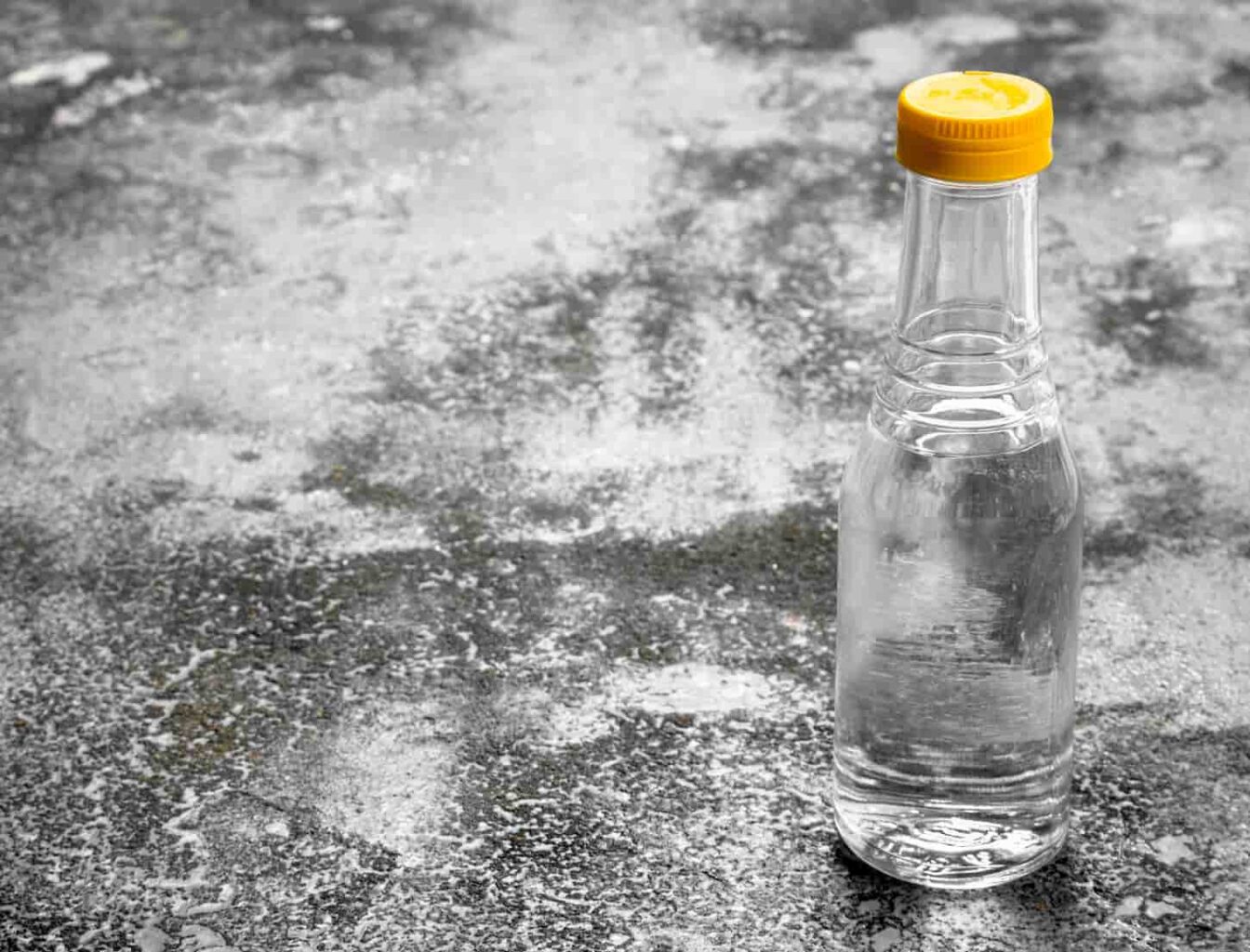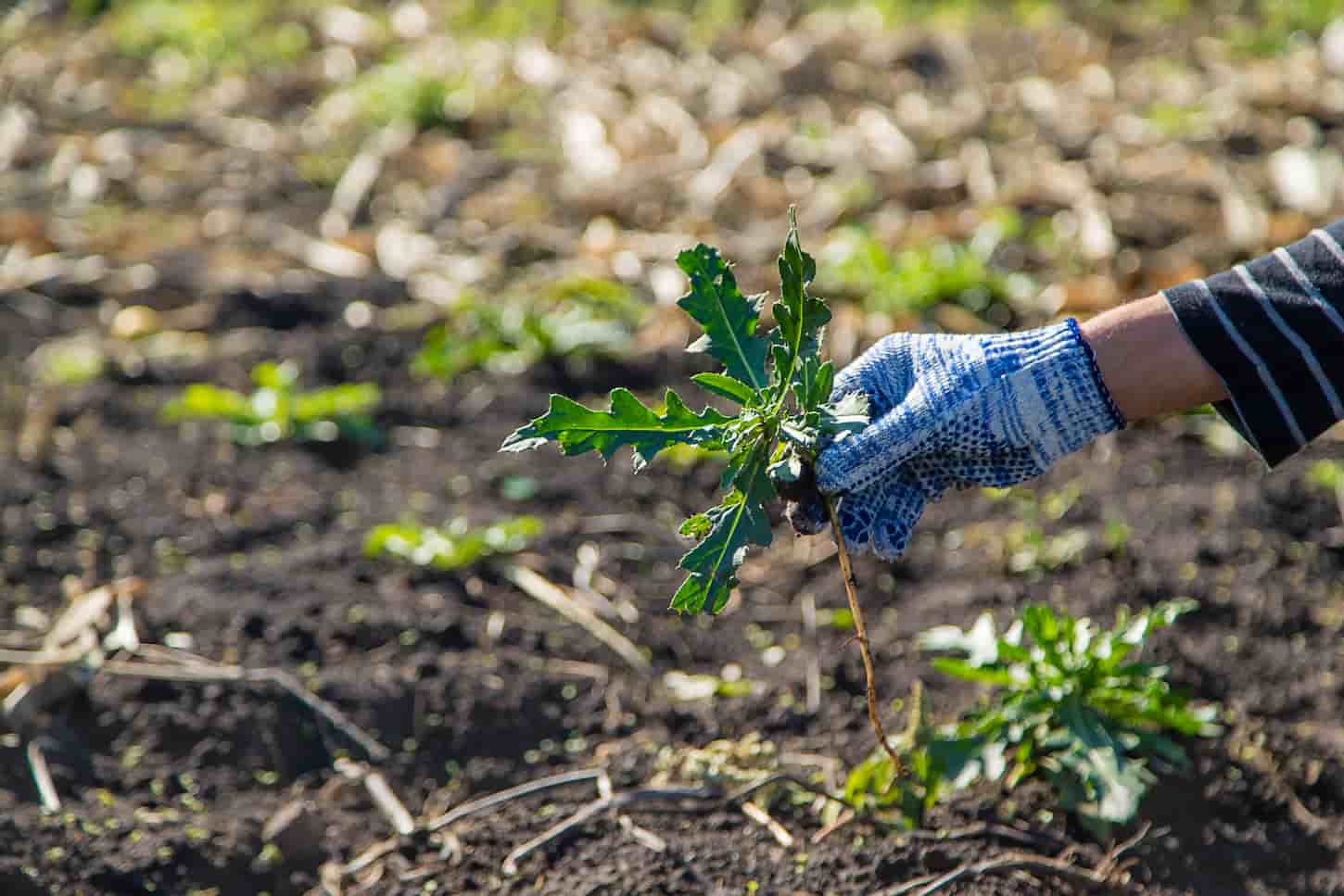Crabgrass is a weed, and just like any other weed, it can spread at incredible speeds. So, when we don’t know what to do and look for advice on the internet, we might see people recommending vinegar as a crabgrass killer. But does vinegar kill crabgrass?
Vinegar will kill crabgrass. Vinegar is almost 100% effective at killing weeds as it makes the soil too acidic for them to survive. However, it is a short-term control method, and people should not rely on it throughout the year.
Read on to learn all about crabgrass and vinegar, why vinegar works, and just how effective it is, as well as how to keep a crabgrass-free yard!

Does Vinegar Kill Crabgrass?
Vinegar does actually kill crabgrass (vinegar is used as an everyday herbicide very often). We can use vinegar for weeds because it contains acetic acid (usually 5%).
Spreading vinegar onto the garden can make the soil too acidic for the weeds to grow successfully.
Will straight vinegar kill crabgrass?
Straight vinegar will kill crabgrass. An experiment was conducted at Cornell University, where they tested various herbicides and commercial vinegar, which was proficient at killing the weed.
According to the Cornell study, all acetic acid products (vinegar included) caused dramatic damage and browning of foliage. Within 24 hours of application, all plants were between 95% and 100% under control.
The difference between commercial vinegar (with 5% acetic acid) and herbicides (that use about 20-25% acetic acid) only becomes apparent later.
Two weeks after application, weed control drops to about 75% with straight vinegar, while herbicides keep high-intensity performance.
That being said, with time and compared to other weed-controlling choices, it becomes obvious that straight vinegar is the weakest weed killer.
However, it’s still a great short-term solution.
Will diluted vinegar kill crabgrass?
Unfortunately, diluted vinegar will not have the same effect as straight vinegar on crabgrass (or other weeds). Diluting vinegar lowers its acidity, so gardeners must apply greater amounts of diluted vinegar to crabgrass.
In fact, gardeners sometimes must apply a greater total of vinegar if using diluted vinegar. Even then, it’s possible the diluted vinegar won’t kill the crabgrass.
We must clarify that it depends on how much water dilutes the vinegar. If we dilute a liter of vinegar in a liter of water, we’ll probably see some weed killing, as 1:1 isn’t a big ratio.
However, if we were to dilute a liter of vinegar in two gallons of water, it most likely wouldn’t achieve the desired effects.
What kind of vinegar kills crabgrass?
When buying vinegar for weed killing, make sure it has at least 5% acetic acid.
Multiple kinds of vinegar meet this qualification, so you should always have a couple of choices.
This should be printed on the label, so you shouldn’t have trouble finding it.
Will Grass Grow Back after Vinegar?
Vinegar is a short-term solution for crabgrass, which will return after some time. Invest time (more so than money) in long-term weed management solutions to keep it away from the yard permanently.
Crabgrass produces an incredible amount of seeds – usually more than 100,000 seeds per season. While crabgrass will die at the hand of vinegar or because of the winter, it will certainly return largely thanks to those seeds.
That’s the problem with weeds, isn’t it? They always keep growing.
The alternative is wasting money on vinegar every now and then to pour it on weeds. We should only use vinegar to kill weeds before cleaning them up. Once the weeds are out, we can start with the maintenance and prevent them from growing again.

What Kills Crabgrass Permanently?
Crabgrass is a difficult plant to kill as it is so prevalent. The best way to keep it out of the garden is to do some combination of the following:
- Manage the seed spread to minimize infestation;
- Be smart with water usage and spread;
- Use a mulch to prevent germination and spread;
- Use other plants to crowd out the crabgrass.
- Kill and remove any crabgrass;
Let’s go through these in some more detail.
Manage and minimize the seeds
One of the best ways to control (and eliminate) crabgrass is to manage the seeds. It’s common sense, but these experts take the explanation to a new level (you can read the study here, though I’ve got all their info built into this article to save you time – you’re welcome).
We have to reduce seed production and its spreading to decrease the occurrence of crabgrass. You’ll be happy to hear that the same maintenance activities that improve the lawn also hurt crabgrass.
First, mow the lawn. The height of the mower should always be adjusted to the type of grass (between 0.5 and 1.5 inches for all grasses except for Kentucky bluegrass, up to 2.5, and tall fescue grass, up to 3).
The right lawn height reduces the chance of germination and crabgrass establishment. We can find the entire table at the link in the beginning of the first paragraph.
Water smarter
A vastly important aspect of weed control is water control. Never drown or dehydrate the area, as both conditions make it easier for all weeds, including crabgrass, to invade (whether we’re talking about the yard, lawn, or garden).
Irrigate the lawn only once a week (unless it’s particularly hot).
Mulch, mulch, and mulch
If there is a problem with crabgrass around plants and trees, use mulch to eliminate the crabgrass. Mulch will block sunlight and prevent new weeds from establishing themselves. We might need up to six inches of mulch to successfully cover the weeds.
Mulching will not only crowd out the crabgrass and other weeds, but it will also create a better water-retention ecosystem for the rest of your plants. So it’s a win-win scenario.
Use plants to crowd out weeds
If you don’t want weeds to grow somewhere, you will need to put something else there. So why not use plants you like if you want to crowd out the weeds?
It can be a lawn or whatever else you want. Go crazy.
Then, take care of those plants. If it’s a lawn, fertilize it (this Rutgers study on crabgrass control via proper lawn care is awesome). Or, if you’d rather skip the long science and findings, here’s the quick reasoning.
Fertilizing the lawn will create a dense lawn canopy which will make the soil shady – the lack of sun will prevent the weed and crabgrass seeds from developing.
Kill and remove weeds
Finally, the best way to keep weeds and crabgrass under control is to get rid of them. That way, they won’t be your problem anymore.
Use of herbicides
Crabgrass is easy to control with wide-spectrum herbicides, though it can also kill other plants and a lawn. To only kill crabgrass, it’s best to establish other plants, kill the crabgrass, and then use a pre-emergent to prevent new crabgrass from establishing itself.
There are two basic types of herbicides – pre-emergent and post-emergent herbicides.
- Preemergent herbicides are used before weeds emerge to prevent growth (as the name suggests). It’s crucial to apply them before germination, and the ideal time for your area will depend on your temperature, climate, and a host of other factors.
- Post-emergent herbicides are used on young plants and are for use when crabgrass has already been established. It can be used almost any time, but applying it when the plants are young is best, as it will work best during a growth-heavy phase.
- Then, there are also wide-spectrum herbicides (they kill many plants) and selective or narrow-spectrum (they only kill some).
Before we go into the application of herbicides, let’s first remind ourselves that different regions have different laws regarding the use of herbicides. No matter how simple it is in theory, we may not be qualified to apply herbicides legally.
Check the laws in the area before doing anything, and follow all safety guidelines when using herbicides.
For example, I can apply certain pre- and post-emergent herbicides (commonly available at the local nurseries and plant stores). Still, there are certain commercial-grade herbicides I cannot buy or apply.
Depending on your area, pre-emergent herbicides may need to be applied as early as January (for parts of California) or in late spring (February or March) for most other areas. Keep an eye on your local weather and thawing patterns, though, as this can change when to apply it, even in colder areas.
If we have to apply the preemergent herbicide early, we might need to use it again after about four months.
Preemergent herbicides are, however, the best long-term chemical solution for crabgrass as it prevents it from ever establishing – all we have to do is spray it twice a year.
Mature crabgrass requires more herbicide to control, not to mention we’re more likely to damage the lawn and/or other plants when we apply too much herbicide.
Ideal Long-Term Crabgrass and Lawn Management
So, to ensure that crabgrass doesn’t appear on our lawn, here’s a recap of the checklist of things we have to do.
- Mow the lawn regularly at the appropriate height.
- Water the lawn properly (don’t over or underwater it).
- Use preemergent herbicides (if legal and allowed) every year.
Remember that vinegar is only a temporary solution for killing crabgrass. It won’t prevent it from appearing again. So you can use vinegar to kill crabgrass short-term, but you’ve got to use these other tips to keep your lawn looking sharp.
What Will Kill Crabgrass but Not the Lawn?
Selective preemergent herbicides will not hurt the lawn, while they will kill the crabgrass. There are also selective post-emergent herbicides that will not harm the lawn. Wide-spectrum (non-selective) pre and post-emergent herbicides will hurt the lawn and should not be used.
The downside of vinegar is that it’s a wide-spectrum killer – it will hurt any plant it comes in contact with, including the lawn. This isn’t a problem if we apply it precisely and only to a few plants.
It will, however, become a problem if we have plenty of crabgrass to kill.
Keep all of this in mind when using chemical methods of control.

Verdict: Will Vinegar Kill Crabgrass?
Vinegar will most definitely kill the crabgrass growing in the yard. The bad thing is – it will likely kill the grass around it, too, if we’re not careful. While surprisingly effective, vinegar should only be used as a short-term solution and should be used sparingly in a lawn.
To keep the yard free from crabgrass for a long time, ensure the grass is mown, watered, fertilized, and covered with preemergent herbicides. Combining these methods will ensure that we’re 100% free from crabgrass!
Next Steps
Now that you’re ready to keep the lawn, yard, or garden free from crabgrass, why not uplevel the garden border next? Here are our 17 Low Maintenance Garden Border Ideas to Know Of! It’s a great read, so check it out next. That way, your garden will look great, and you’ll have an easy, low-maintenance border that works to keep plants put.
Resources
Learning from your own experience is essential, but learning from others is also intelligent. These are the sources used in this article and our research to be more informed as homesteaders.
- Crabgrass Management Guidelines–UC IPM. ipm.ucanr.edu/PMG/PESTNOTES/pn7456.html. Accessed 18 Oct. 2022.
- FS1308: Crabgrass Control in Lawns for Homeowners in the Northern US (Rutgers NJAES). njaes.rutgers.edu/fs1308. Accessed 18 Oct. 2022.
- “Using Acetic Acid Vinegar as a Broad Spectrum Herbicide.” rensselair.cce.cornell.edu, rensselaer.cce.cornell.edu/resources/using-acetic-acid-vinegar-as-a-broad-spectrum-herbicide. Accessed 18 Oct. 2022.
